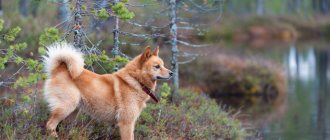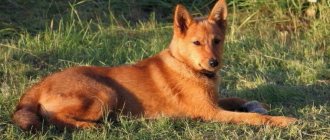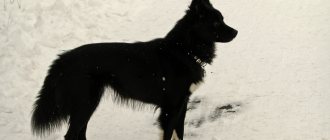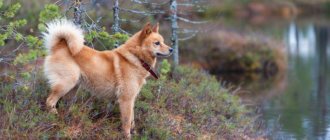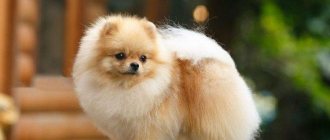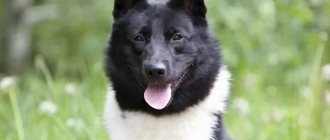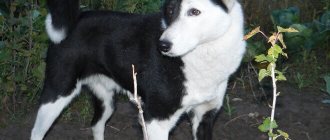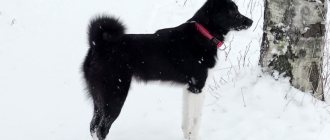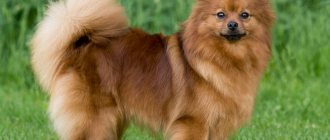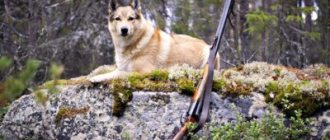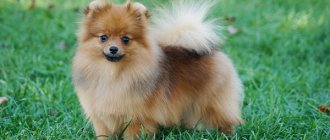| Origin: | Finland |
| Usage: | hunting dog |
| Color: | ginger |
| Dimensions: | height 39-50 cm, weight 7-13 kg |
| Lifespan: | 12-14 years old |
The Karelian-Finnish Laika is a charismatic and cheerful dog with a friendly and fighting character. This is a born hunter, capable of working with a variety of game. Modern representatives of the breed make excellent companions - loyal and courageous. Animals are distinguished by a peaceful disposition, however, in order to adequately raise a puppy, you need to make a lot of effort, show persistence and patience.
Description of the Finnish Spitz breed
Popularity 93rd place among 263 dog breeds
Lifespan:
12-14 years old
Height:
males: 42-50 cm, females: 38-46 cm
Country of origin:
Finland
Average price:
30-40 thousand rubles
Weight:
males: 12-13 kg, females: 7-10 kg
Latest articles Cat health
Rabies vaccination for cats: choice of vaccine, necessity, schedule 01/22/2022 4 0 0
Selection and adaptation
TOP 20 best cat breeds for families with children 01/22/2022 25 0 0
Family life
Dogs need long walks every day. Strike a balance between family time and outdoor exercise.
By nature, they get along well with children, so they can act as a nanny.
Despite all the love and care a Spitz may have for its family, it will be wary of strangers and will not show affection. This breed has an excellent protective instinct.
They are wary of strangers.
Teach your dog good manners and discipline from an early age.
Key facts
The name of the breed, Finnish Spitz, is not native to dogs of this breed: in the 2000s they had a different name - Karelian-Finnish Laika. In discussions, dog owners use the abbreviated name - Karelian. The description of the Finnish Spitz breed according to standards also developed not so long ago.
Energy, dominance, cunning, friendliness - these are the characteristics of the Finnish Spitz breed and those qualities that are most often found when describing dogs whose country of origin is considered to be Finland. They try to choose a sonorous, biting nickname for the pet - Russian or Finnish.
Males and females equally exhibit characteristics characteristic of the breed: they love to hunt, get along well with a large number of people, show excessive independence, and often make noise.
In addition, Finnish Spitz males and females are fearless, brave, loyal, but will never put their lives in danger. A dog will only obey the person it deems worthy.
The dimensions of the Finnish Spitz are quite compact, which allows keeping a dog of this breed in an apartment. The height (height at the withers) of the animal ranges from 38 to 50 cm, weight – from 7 to 13 kg; these indicators depend on the animal’s lifestyle and gender. The life expectancy of the Finnish Spitz is considered long - Karelians live up to 14 years.
Keeping a dog of this breed requires effort and a certain amount of money: daily active walks, brushing, buying a large amount of food. The price for a Karelian-Finnish Laika starts from 25,000 rubles; The average cost in Russia is 60,000 rubles.
Photo
In the photo you can see what representatives of the Karelian-Finnish husky look like:
Red-haired Finnish Husky
On a walk
Family
History of the origin of the Karelian-Finnish Laika
Karelian-Finnish Laikas, despite the officially recognized patronage of Finland, have Russian roots. The breed began to exist thanks to Russian breeders who crossed two types of hunting dogs - Karelian and Olonets. The first participation of a dog of this breed in an exhibition occurred in 1936. Finnish Spitz imported into the USSR were registered as Karelian-Finnish huskies, which gave breeders the opportunity to cross them with purebred Karelians.
Mestizos quickly filled the territory of the country due to the great popularity of the breed. After long discussions, members of the Russian Cynological Federation came to the conclusion that the best solution would be either to merge the domestic dog breed with the Finnish one, or change the name - the choice fell on the first option.
At the moment, the Karelian is bred in Russia separately from the Finnish Spitz, but is not distinguished as a separate breed. A standard designed to make animal breeding easier does not serve its primary purpose; Some breeders also note that the working qualities of dogs of these breeds differ.
Mating
Finnish Spitz are a slow maturing breed. It is undesirable to obtain offspring from representatives under 2 years of age . If the animal has reached the age of maturity, has a documented pedigree and show scores, it can be allowed for breeding.
The selected candidate for offspring must have genes that will only emphasize the advantages of both parents in the puppies. You can find a match for your pet:
- By contacting a kennel club;
- By agreeing directly with the breeder of the selected partner during the exhibition or by advertisement.
Before the meeting, it is necessary to treat the future parents for helminths, check the condition of the claws, and trim them if necessary. The dogs are introduced to the male's territory, where he can feel comfortable. For greater effectiveness, mating is repeated 2-3 times at intervals of a day.
Read a detailed article on the topic: “Everything you need to know about breeding dogs: appropriate age, what to do if it doesn’t work out, rules and tips.”
Appearance of the Finnish Spitz
General impression
What does a Karelian woman look like? In the photo, the Finnish Spitz looks like a fluffy, mischievous ball of fur, whose appearance and habits are reminiscent of a fox - this is how dogs of this breed can be characterized. The animal looks impressive due to its dense build, and is suitable for keeping in spacious apartments - the size of the fluffy dog is quite compact for medium-sized dogs.
Head
The head is proportional to the body, wedge-shaped, with a pronounced stop. The slightly pointed muzzle, wide at the base and of normal length, has high cheekbones and is reminiscent of a fox. Standing well on top of the head, the triangular ears have hard cartilage.
The slanted oval eyes are usually either brown or a color that matches the fur color. The small nose with movable, well-opened nostrils is completely black. A scissor bite with heavy jaws is characteristic of dogs of this breed. The lips fit tightly to the white teeth.
Neck
The neck is of normal length allowing the animal to hold its head proudly. The muscles are well developed.
Torso
The body resembles a square. The wide back smoothly transitions into a rounded croup. The chest is lowered to the elbows, poorly defined. The muscles are well developed.
Forelegs
The straight forelimbs, standing parallel to each other, are quite powerful. The paws are rounded and lumpy. The claws are black, the pads are dark. The bones are strong. The muscles are well developed.
Hind limbs
Just like the forelimbs, the straight hind legs stand parallel to each other. Rounded fleshy thigh, muscular lower leg. The hock joint is well defined. The paws are rounded and lumpy. The characteristics of the claws and pads are the same as those of the front paws.
Tail
The tail, which reaches the hock joint, is in a calm state, wrapped in a ring and lowered onto the back. When excited, it is held above the back in a ring.
Movements
The dog moves easily and abruptly. Slow walk and gallop are the most typical types of gait for dogs of this breed.
Wool
The abundance of straight, slightly fluffy hair suits Karelians. The presence of fringes is unacceptable. The dense undercoat requires careful care during the molting period.
Color
What colors are typical for Karelian women? The color of the Finnish Spitz resembles the color of a fox's fur in various shades of red (the preferred shades are fiery red, a mixture of brown and red). There may be light or white spots on the chest.
Size
Carelkas are quite compact for huskies, which makes their maintenance convenient even in a medium-sized apartment. According to the standard, the normal weight of Finnish Spitz boys is from 10 to 13 kg, height at the withers is from 42 to 50 cm. Girls are slightly smaller: weight from 7 to 10 kg, height from 38 to 42 cm. The weight of the Finnish Spitz may vary depending on the larger side while maintaining the proportionality of the animal.
An excerpt characterizing the Swedish Lapphund
“Yes, yes, it’s true,” said Pierre, smiling cheerfully. - Yes, yes, I don’t need any of this. I became much richer from ruin. But in January Savelich arrived from Moscow, told about the situation in Moscow, about the estimate that the architect made for him to renovate the house and the Moscow region, speaking about it as if it was a done deal. At the same time, Pierre received a letter from Prince Vasily and other acquaintances from St. Petersburg. The letters talked about his wife's debts. And Pierre decided that the manager’s plan, which he liked so much, was wrong and that he needed to go to St. Petersburg to finish off his wife’s affairs and build in Moscow. Why this was necessary, he did not know;
but he knew without a doubt that it was necessary. As a result of this decision, his income decreased by three quarters. But it was necessary; he felt it. Villarsky was traveling to Moscow, and they agreed to go together. Pierre experienced a feeling of joy, freedom, life throughout his recovery in Orel; but when, during his travels, he found himself in the free world and saw hundreds of new faces, this feeling intensified even more.
Where Villarsky saw deadness, Pierre saw an extraordinary powerful force of vitality, that force that in the snow, in this space, supported the life of this whole, special and united people. He did not contradict Villarsky and, as if agreeing with him (since feigned agreement was the shortest way to bypass reasoning from which nothing could come of it), smiled joyfully as he listened to him.
Just as it is difficult to explain why and where ants rush from a scattered hummock, some away from the hummock, dragging specks, eggs and dead bodies, others back into the hummock - why they collide, catch up with each other, fight - it is just as difficult It would be possible to explain the reasons that forced the Russian people, after the French left, to crowd into the place that was formerly called Moscow.
Everything was destroyed, except for something insubstantial, but powerful and indestructible. The motives of people rushing from all sides to Moscow after its cleansing from the enemy were the most varied, personal, and at first mostly wild, animal. There was only one impulse common to everyone - this desire to go there, to that place that was formerly called Moscow, to carry out their activities there. After a week there were already fifteen thousand inhabitants in Moscow, after two there were twenty-five thousand, etc.
Rising and rising, this number by the autumn of 1813 reached a figure exceeding the population of the 12th year.
The first Russian people who entered Moscow were the Cossacks of the Wintzingerode detachment, men from neighboring villages and residents who fled from Moscow and were hiding in its environs. The Russians who entered devastated Moscow, finding it plundered, also began to plunder. They continued what the French were doing. Convoys of men came to Moscow in order to take away to the villages everything that had been thrown along the ruined Moscow houses and streets.
But after the first robbers came others, third ones, and the robbery every day, as the number of robbers increased, became more and more difficult and took on more definite forms.
The French found Moscow, although empty, with all the forms of an organically correctly living city, with its various departments of trade, crafts, luxury, government, and religion. These forms were lifeless, but they still existed. There were rows, benches, stores, warehouses, bazaars - most with goods;
We invite you to familiarize yourself with the Care and maintenance of the bear-type dwarf Pomeranian Spitz
The longer the French remained, the more these forms of urban life were destroyed, and in the end everything merged into one inseparable, lifeless field of robbery.
The robbery of the French, the more it continued, the more it destroyed the wealth of Moscow and the forces of the robbers. The robbery of the Russians, with which the occupation of the capital by the Russians began, the longer it lasted, the more participants there were in it, the faster it restored the wealth of Moscow and the correct life of the city.
In addition to the robbers, the most diverse people, drawn - some by curiosity, some by duty of service, some by calculation - homeowners, clergy, high and low officials, merchants, artisans, men - from different sides, like blood to the heart - flowed to Moscow.
Character of the Karelian-Finnish Laika
A dog is a man’s friend, Karelians definitely fall under this definition. They are friendly, affectionate, somewhat naive, but at the same time self-sufficient, self-willed, and proud. The Finnish Spitz will be faithful only to the person who has earned his trust.
The pet will respond with kindness to a good attitude towards itself, and with anger and aggression (which are not considered distinctive features of the breed) to a bad attitude. If you have a dog of this breed, the best solution would be to treat the puppy with care from the first minutes of its presence in the house - then a favorable relationship will be a strong foundation for subsequent contact. The Finnish Spitz's character will develop successfully; there will be no deviations in the dog's psyche.
Karelka doesn’t mind playing with children (especially in the winter outdoors, having snowball fights), but other animals, especially those of the same sex as the dog herself, will give her mixed feelings.
On the street, the Finnish Spitz will be an important person, enjoying the attention of passers-by (its bright appearance contributes to this); at home, it will be a calm but lively companion to all family members. Dogs of this breed are very friendly, but do not like large crowds of people, so keeping them in small apartments is not recommended.
How do Finnish Spitz differ from others? Dogs of this breed have developed empathy, so the owner may think that the pet knows what will be asked of him in advance. This also helps the animal quickly evaluate the stranger - if he is unfriendly, the Karelian will immediately let you know about it with a loud bark.
Who is a Karelian-Finn suitable for? An active person who enjoys walking with his pet will be an ideal owner for a Karelian. An interesting life is guaranteed for the person who helps a Finnish woman understand how big and wonderful the world is.
Memory of past lives
Figure 3. Jung put forward the version that déjà vu is the result of genetic memory. The lack of accurate knowledge about the mechanisms of déjà vu has given rise to various guesses and mystical versions. Among them is the hypothesis that the phenomenon is associated with previous human lives, i.e., reincarnation. The incredible version, however, aroused the curiosity of specialists from different fields of knowledge at all times.
Remarkable! This version is completely contrary to the philosophy of Christianity. Since, according to religious canons, a person comes to earth only once. His task is to live his life in such a way that he will not be afraid to appear before God during the final Judgment.
The first version that déjà vu is a residual memory of past lives was expressed by Carl Gustav Jung. To avoid the mystical term “reincarnation,” he renamed it genetic memory.
It must be said that the Swiss theory is popular among his contemporaries. Many stars share their memories from past lives. For example, Madonna claims that in a past life she was one of the many servants of the Emperor of Manchuria. It’s interesting that she learned about this after feeling déjà vu while visiting the imperial palace in Beijing.
Another interesting story was told about herself by singer Tina Turner. Turner shared with the press that in one of her earthly incarnations she was the queen of Egypt - Hatshepsut.
Education and training
Is it possible not to raise a four-legged friend? Like any other dog, the Karelian-Finnish Laika needs education and training. The foundations of good manners are laid by the breeder in the kennel, then the new owner only develops the qualities inherent in the puppy.
What should the education and training of a Finnish Spitz be like? Teaching the basics of good behavior should begin from the first moments of your four-legged friend’s stay in the house. Thanks to short, play-like training, a two-month-old puppy will quickly master the basic commands: “sit!”, “lie down!”, “come!”
Exercises must be performed constantly so that the baby does not forget anything. In addition, you need to rid your dog of bad habits. It is at this age that dog handlers often hear the questions “how to stop chewing slippers?”, “how to teach them to go to the toilet on the street?”
At the age of six months, you can start taking a young dog to courses, where a dog trainer will help you find and correct “irregularities” in the relationship between owner and pet, and teach complex commands; In addition, the dog will be able to communicate with older individuals, which will help to adopt their good habits. The best periods for taking courses are considered to be autumn, winter, spring, and summer will be a good time to relax.
A well-mannered, trained Karelian is not uncommon, since dogs of this breed are very smart. It is important to establish contact with the dog, since he will not listen to a person who means nothing to him; It is noted that screaming and the use of brute force are unacceptable in relation to a dog, because this leads to mental damage.
Application
Red huskies are versatile dogs. These pets enthusiastically hunt a wide variety of game - birds, ungulates, fur-bearing animals. Some individuals of the breed successfully work for bears, beavers and other animals. When hunting, the Karelian husky makes its own decisions, driving the prey directly towards the person. This makes her an indispensable partner.
Modern dogs of this breed are often bred as companions. Karelian Laikas are very loyal to people, ready to accompany their owner everywhere and help him in all matters. In order for a Finnish Spitz to be happy, it must be constantly loaded with work and freedom of movement must not be limited.
Health and diseases of the Karelian-Finnish husky
The Finnish Spitz is distinguished by its health due to successful natural selection; In addition, the mixture of blood played a significant role. Representatives of the breeds rarely develop allergies to food and the environment. Provided that the norm of nutrients supplied to the animal’s body is observed, its health will be safe. Like any other dog breed, Finns have a chance of developing obesity due to excess nutrition, and not defects in the functioning of the endocrine system.
Diseases of the ears, mucous membranes of the nose or eyes, inflammation of the oral cavity (teeth or gums), hair loss in the muzzle, groin and tail areas bypassed the Karelians, but diseases of the musculoskeletal system and nervous system became a kind of retribution for this.
Possible diseases
Representatives of this breed are susceptible to dysplasia of the paw joints (the hock and hip joints are most often affected). In addition, Karelian-Finnish huskies often develop epilepsy.
Reproductive health
The first heat in bitches comes at the age of 10-12 months. Veterinarians do not advise having offspring during this period, since the dog’s body may not complete its formation, which leads to complications requiring expensive treatment (for example, difficult childbirth). The best period for mating will be the third and subsequent heats: at this age, the birth of puppies will not be a shock to the bitch’s body.
It is important to take care of the issues of keeping the bitch and puppies after giving birth (what to feed, where to equip an enclosure for the babies, where they will go to the toilet), agree with the veterinary clinic about examinations, preventive vaccinations, and make documents for the offspring. If the owner is not ready for such “tests,” the best solution would be to sterilize the female.
Is deja vu good or bad?
Usually deja vu has a neutral meaning. However, if the phenomenon occurs to a person often, then this may be a harbinger of illness. After all, Aristotle warned that déjà vu is a malfunction of the brain that leads to serious psychological illnesses.
The words of the ancient philosopher are confirmed by experts. For example, Professor Chris Moulin talked about one of the patients at the Memory Disorders Clinic in Bath. The patient was tormented by constant obsessive déjà vu. This was due to the loss of brain cells caused by dementia.
There are many cases recorded in medicine where frequent repetitions of reality were a sign of psychological illness. It is recommended that people analyze the past less:
- with a receptive nervous system;
- patients with epilepsy;
- experiencing certain psychological problems.
Features of feeding and diet
What to feed your Finnish Spitz? This question is really relevant for owners of such active dogs, since food must cover the energy consumption of their four-legged friend, taking into account the BZHU norms. Information about your pet's needs can be found in the puppy feeding guide or the adult dog feeding guide, depending on the age of the animal.
There are two types of diets - natural and feed. Both types should be varied, balanced in proteins, fats and carbohydrates. Usually, such little things are taken into account by manufacturers of dry dog food, so “drying” is considered the best option for feeding.
A diet consisting of natural products is much more difficult to organize: it is important to take into account the animal’s food intolerances, prepare a “menu” in advance, buy food, and cook.
The owner decides what food to feed the dog after two to three months of living together, since the breeder chooses the puppy’s food for the first months of life. Which food to choose? The best choice would be premium products.
On a natural diet, you can give your dog the following foods:
- fresh seasonal vegetables (root vegetables excluded);
- fresh seasonal fruits (except citrus fruits);
- lean meats;
- poultry meat;
- lean sea fish;
- offal;
- whole grain cereals (for example, brown or wild rice, buckwheat);
- healthy vegetable fats (nuts, unrefined vegetable oils);
- dairy products.
Is it possible to give an animal fatty, fried foods, or add too spicy spices? In no case, since the digestive tract can be seriously damaged.
How much to feed and how many times to feed your four-legged friend depends on the age of the dog. The two-month-old puppy eats six small meals a day. A six-month-old baby is fed three times a day. An adult dog receives two servings of food per day. The portion depends on the weight of the pet and its activity during the day.
Theses
- The breed was on the verge of extinction, but fanciers saved it.
- This is an exclusively hunting breed, its instincts have evolved over thousands of years.
- She barks and barks a lot. In Finland they even hold barking competitions.
- Loves people and children, well suited to living in a home with small children.
- But he gets along so-so with other animals, but you can train him not to react to pets.
Care and maintenance
Caring for and maintaining a Finnish Spitz does not bring much trouble to the owner. The animal needs constant close communication with members of the household, participation in their lives; a warm corner and favorite toys will make your four-legged friend happier.
Caring for a Karelian is easy. Fluffy fur hardly tangles, requiring a little attention - combing two to three times a week, washing twice a month (more frequent bathing can lead to changes in the skin microbiome, which leads to hair loss).
Shedding occurs twice a year - at this point the fur requires more careful care. After washing, it is necessary to examine the ears to exclude the appearance of ear parasites, brush the teeth to prevent problems with the oral cavity, and trim the nails (especially in winter, when the animal is not able to grind them off on the asphalt on its own).
A daily procedure is to wash the eyes with warm water or chamomile infusion. In the summer, it is important to examine your pet after walks for ticks, because these parasites cause serious damage to the dog’s health.
A visit to a groomer (a professional who takes care of the dog’s appearance, including washing and cutting) is necessary only for those representatives of the breed who are regulars at exhibitions. For other dogs, these procedures can be performed at home.
Memory error - the opinion of scientists
Figure 2. Scientists claim that déjà vu is a memory error The state of “déjà vu” was first described by the French psychologist Emile Boirac in the book “Psychology of the Future.”
The Frenchman was the first to define the term. After the publication of the book, a lot of other works appeared on this topic. The phenomenon was considered from both a scientific and mystical point of view. However, no accurate information has been added, since this phenomenon is spontaneous and individual. It is impossible to use technical instruments to analyze it. In 2006, an attempt was made to analyze déjà vu using hypnosis. It was based on the fact that when a person recognizes events or people as familiar, something like this happens. The brain goes through the memories, and in case of coincidences, another area of the brain establishes the authenticity of the ongoing process. It turns out that déjà vu is the launch of the second part of information processing by mistake.
There were other theories:
- short-term and long-term memory fails, i.e. momentary information is directly sent to long-term memory;
- somehow the area of the cerebral cortex that controls familiar sensations is activated without the participation of memory;
- Déjà vu is a memory disorder.
Video
Documentary film of the TV channel “Russia 1” - “Deja Vu. Someone else's memory."
Tips for choosing a puppy
How to choose a Finnish Spitz? When choosing a dog, you should start by familiarizing yourself with the list of kennels. It is important to make sure that the selected breeder keeps the Finnish Spitz puppies and the bitch in good conditions, to get to know the parents in order to exclude the presence of negative qualities that in one way or another affect the baby’s communication skills. Then the future Karelian owner should pay attention to the behavior of the puppies. The best option would be an active, curious baby.
Before purchasing, you can take advantage of the breeder’s consultation (the cost is often included in the price of the puppy), when he will help you choose the best option based on the wishes of the future owner. It is important to make sure that all documents are available (puppy certificate of the Russian Canine Federation and a veterinary passport indicating the vaccinations completed).
Dream or work of the subconscious
Sigmund Freud theorized that déjà vu is the recollection of images from our forgotten dreams. This version is supported by modern dream researchers. The fact is that a person mainly dreams of scenes related to everyday life. While we sleep, the subconscious processes possible options for the development of an event that worries us at this moment in life.
And since a person rarely remembers his dreams, when something similar happens in reality, it seems that this has already happened to us. This phenomenon is based on this effect. It turns out that deja vu is the options for the development of an event calculated in a dream by the subconscious.
